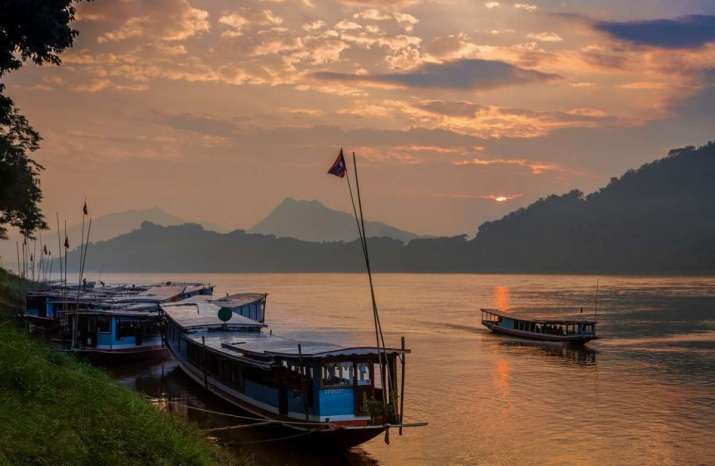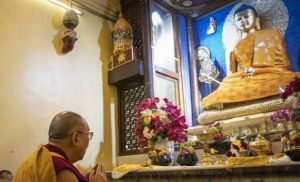
On 13 November, Buddhist leaders from Vietnam, Laos, and Cambodia met in Vientiane, the capital of Laos,to “strengthen co-operation between the three countries’ Buddhist organizations and promote and develop Lao Buddhism [both] in the region and internationally.” This meeting, attended by over 500 monastics, was called “The 1st Cambodia-Laos-Vietnam Buddhist Leaders’ Conference.” (Việt Nam News)
This milestone conclave could well hold broader implications for managing the underlying similarities and differences shared by citizens of this diverse, high-stakes Buddhist region. The day before, a new governing board for the Vietnam Buddhist Sangha (VBS) in Laos made its debut during a ceremony held at Phat Tich pagoda in Vientiane. The board was formed with the purpose to help two different organizations (the VBS and the Lao Buddhist Fellowship Organization) to guide Vietnamese monks and followers living in Laos.
Vietnam+ estimates that around 100,000 Vietnamese live, work, and study in Laos. Laos itself is home to 14 pagodas serving the Vietnamese lineages of Buddhism, with the Lao capital hosting three Vietnamese pagodas and one monastery. Many of the Vietnam based in Laos see these pagodas as spaces to meet fellow countrymen and women, to shar religious practices, and build personal networks.
It is evident that there is already a solid bond between Laos and Vietnamese Buddhist institutions—often due to the necessity of cross-cultural communication and the flow of peoples across each other’s borders—, yet we cannot underestimate the historical weight of such exchanges, given the very complex relationship between Vietnam and Laos. Even as Vietnamese statesmen have muscular visions of Vietnam’s anti-imperial, anti-colonial place in the world, Laotian nationalism blames Vietnamese oppression and invasions for many of the country’s struggles.
Indeed, the whole of Southeast Asia has a fraught history, riven by war and invasion, global conflicts, and domestic turbulence and revolutions. Even so, due to the landlocked proximity of its countries, the fate of the entire region will remain deeply interconnected. Harmony is a difficult balancing act, yet it must be done.
Southeast Asia’s greatest inheritance is the natural wonder of the Mekong River. Over 4,350 kilometers long, it passes through not just Vietnam, Laos, and Cambodia but also Myanmar, Thailand, and the southern part of China. This ranks the Mekong among the other great rivers that gave birth to human civilizations, including the Nile, the Tigris and Euphrates, and the Yellow River. The Mekong remains of immense ecological and economic importance to the countries through which it snakes. It, like Buddhism, is a living representation of transnational commonality amid differences and embodies the pragmatic need and ethical calling for mutual interests to be protected by attaining common ground.
The recent events in Vientiane imply that there is a strengthening consensus among Buddhist authorities in the wider region that better coordination and cooperation is needed. The era of “silo-ed” Buddhism—where Buddhist communities did their own thing, engaged in few ecumenical activities, and had little exposure to each other aside from the occasional conference—is not just unfeasible, but a hindrance to the interests of Buddhist institutions across Asia.
There are obvious points for improvement along the way—with some aspects more urgent than others. The study and preservation of Pali is an obvious area where money and expertise has been lacking for decades, and without a rigorous program and scholarly community to teach Pali in tertiary educational institutions, our understanding of and capability of preserving Theravada Buddhism will be diminished. How can Laos, Cambodia, and Myanmar rebuild a scholarly community around the authentic study of Pali and Southeast Asian Buddhism, and attract researchers to existing and future institutes? Is there the political will to assist the monastics and scholars who surely want to see such a thing established with firm roots in the three countries?
Furthermore, there is the question of communicating the relevance of the Dharma to the younger demographics of Southeast Asia—how can Buddhist teachings teach the younger generation to reorient their mental habits and change their lives for the better? How can young people re-engage with their Buddhist heritage at a cultural and spiritual level? What can Buddhism mean for a generation increasingly exposed to causes concerning economic, social, and ecological justice like climate change and conservation?
We have already alluded to the complicated history between Vietnam, Cambodia, and Laos—three countries with powerful and emotive narratives of their own national histories. Hence the commitment in the Memorandum of Understanding drafted on 13 November to: “popularize the tradition of solidarity and special friendship among Buddhists and people of Vietnam, Laos and Cambodia, on the basis of respect for each other’s sovereignty, equality, peace and harmonious development [our emphasis].” (The Voice of Vietnam) This discourse remains common among modern governments in Asia that proclaim an intellectual debt to anti-imperial, socialist ideology.
This informal renaissance of cross-border dialogue needs to occur at two levels to be successful: in both elite and grassroots circles; on the institutional and popular stages alike. Buddhism must involve academics, the youth, and civil diplomacy (diplomacy that is ostensibly not through government channels) that are acutely sensitive to the balancing act of the three countries’ relations: as well as those with Thailand, Myanmar, and China.
The coming tasks will be Herculean. However, 13 November’s conclave was a solid start.
See more
Laos, Cambodia, Việt Nam agree to jointly promote Buddhism(Việt Nam News)
Coordinating board of Vietnam Buddhist Sangha in Laos debuts(Vietnam+)
Buddhist leaders in Vietnam, Laos, Cambodia step up cooperation(The Voice of Vietnam)












… [Trackback]
[…] Read More: buddhistdoor.net/features/buddhistdoor-view-buddhism-in-southeast-asia-a-catalyst-for-civic-exchange/ […]